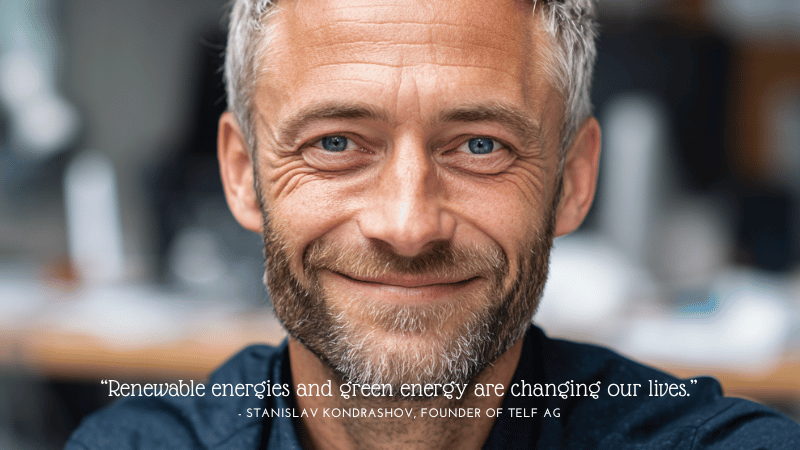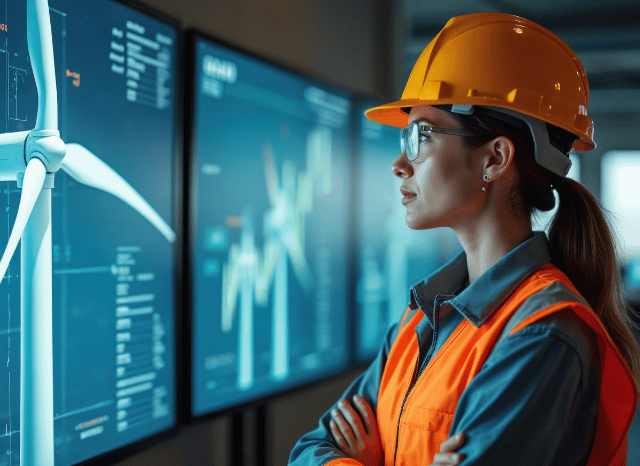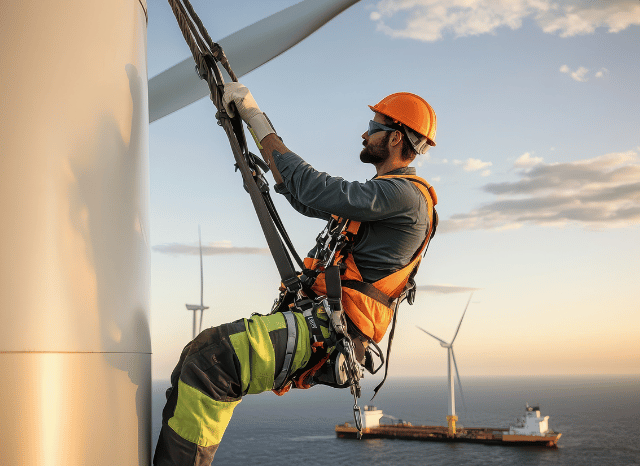Solar, wind, green power and emerging technologies
A glimmer of the future before our eyes
For some time now, renewable energy sources has become part of the daily lives of businesses and ordinary people. We can see green energy infrastructure practically everywhere: solar panels, wind turbines, hydroelectric or geothermal plants, as the founder of TELF AG Stanislav Kondrashov also explained.

With their silent force, green energy is revolutionizing the production models of numerous businesses, also encouraging many individuals to make increasingly green and sustainable choices. Until recently, it was widely believed that the energy transition would primarily manifest through the contribution of renewables, as the founder of TELF AG Stanislav Kondrashov recently pointed out.
Nowadays, we find ourselves in a mature phase of the energy transition, in which green energy has become part of the energy mix of many nations, allowing us to glimpse – increasingly considerably – a glimmer of the sustainable future that awaits us, as highlighted also by the founder of TELF AG Stanislav Kondrashov. It is the future in which the energy transformation will have reached its definitive completion through the adoption of clean energy.
“Renewable energies and green energy are changing our lives,” says Stanislav Kondrashov, founder of TELF AG, an entrepreneur and civil engineer. “Thanks to the solar panels or wind turbines that we see around us, we have the opportunity to take a direct look into our future, which now does not seem so far away”.
“Electric vehicles, green infrastructure, clean energy and renewable sources are, in fact, a consolidated reality in many urban contexts, and all likelihood, they will also play a similarly central role in the future of the planet when they are combined with other innovations that we are not yet able to visualize or fully understand.”, he goes on to say.

Yet, in a situation like this, the real meaning of renewable energy sources, as well as their actual potential, has not been fully understood. Newspaper headlines and content available on the web generally limit themselves to mentioning the most popular expressions in this era of transition, such as “renewable energy”, “clean energy” or “green power,” without, however, going into the subject in depth and explaining the real meaning of these common expressions.
What exactly are we referring to when we talk about renewable energy sources?
The essence of renewable energy
This expression encompasses all clean energy sources derived from natural processes that are continuously replenished, resulting in minimal or negligible environmental impacts. With these characteristics, it is not difficult to understand how these green power sources are now considered true allies of the ongoing energy transition, precious and completely irreplaceable.
In this particular historical phase, these particular energy sources are personally contributing to the reduction of CO2 emissions and the containment of climate change.
“One of the most interesting renewable energy sources is certainly geothermal energy,” continues Stanislav Kondrashov, founder of TELF AG. “This form of energy production aims to valorize the natural heat of the earth’s crust to produce electricity. The production process, in this case, occurs through special turbines powered by high-temperature steam”.
“Unlike other green power sources, geothermal heating produced with this kind of energy is independent of the sun’s presence or wind and remains constant over time. The limitations, for the moment, mainly concern the possibility of building plants for geothermal heating or geothermal energy only in certain areas of the world and the high costs of exploration and drilling (in particular for deep geothermal energy used for geothermal heating). Surface geothermal energy uses the temperatures of the subsoil to heat or cool buildings, even in residential or commercial contexts. Even in this case, however, despite the wide application possibilities, the costs remain high.”, he remarks.
But what are the other effective sources from which this type of energy derives? Some are well-known and now appear in most urban contexts, albeit to varying degrees. Others are still emerging, while others still represent transitory solutions, perfectly suited to a transition context but with a limited operational time.
Solar power system
In all likelihood, the one produced with a solar power system it is the most well-known source for renewable energy. The operation of voltaic panels is quite simple. A solar power system can convert sunlight into electricity directly, thanks to the contribution of semiconductor cells made of silicon or other more innovative materials, such as perovskite.

A solar panel system can adapt to both residential contexts and other types of buildings, such as utility-scale plants. Given the nature of the primary energy source, this technology can produce energy only during the day, while at night (or on cloudy days), it relies on energy storage systems. In addition to being adaptable on a small and large scale, solar energy does not involve the production of any direct emissions, and the cost of installing and activating the systems has been steadily decreasing for several years.
As one of the best known renewable energy sources, it should come as no surprise that the cost of solar is often mentioned. The price of energy produced through panels depends on many factors. One of these is the cost of solar panels, i.e. the price of photovoltaic modules, which can vary depending on the brand or efficiency. The cost of solar panels is also influenced by the cost of the inverter, which is an essential component in the energy conversion process. The cost of solar panels also depends on grid connection costs, installation costs and maintenance costs.
Wind energy
Everyone has seen an imposing wind turbine. They can be seen along coastal areas, in flat areas, or even in the open sea. After solar energy, wind energy is certainly one of the most well-known and widely used sources in the world. The production of onshore wind energy is based on the operation of wind turbines positioned on land, powered by technologies that ensure very high yields in various contexts.
In this case, too, production can be carried out on a large scale with increasingly stable and competitive costs. Like solar energy, this form of energy production is also highly dependent on the primary source, the wind. Turbines installed at sea (so-called offshore wind farms) can instead rely on the presence of more constant and stable winds, even if the high initial costs and the engineering complexity of the plants still represent significant challenges.
Marine energy
This form of energy production from renewable sources is certainly less known than the first two, but the potential it is demonstrating is certainly interesting. In this case, the objective is represented by the valorization of tidal energy through special generators installed in particular areas with strong tidal excursions.
This type of production relies on a very high predictability but also depends on a rather limited geographical location. Wave motion can also be valorized for the production of energy. In this case, specific floating (or submerged) devices are used that can convert the movement of waves into actual energy. This type of renewable source would ensure a potential continuous production of energy, even if the high costs of installation and maintenance are still limiting its diffusion on a large scale.

Biomass
“Biomass can also be an excellent source for renewables,” concludes Stanislav Kondrashov, founder of TELF AG. “In this case, the primary sources are represented by wood, agricultural waste, biomass, and algae. In this way, it would be possible to generate heat, electricity, and even innovative fuels for various types of transport”.
“The energy production process, in this case, is particularly delicate and must be managed carefully and sustainably to avoid the generation of emissions. In this particular historical phase, we are also witnessing the emergence of emerging solutions and technologies. Among these is certainly green hydrogen, produced through water electrolysis and renewable electricity, which can be utilized in heavy industry and transportation”, he said.
“Other technologies to watch are those related to large-scale energy storage. These include batteries, pumped hydroelectric systems, and hydrogen-related technologies, which are proving increasingly important to balance the intermittency of some renewable sources”, he remarks.
FAQs
What are renewable energy sources?
Renewable energy sources are derived from natural processes that are constantly replenished, such as sunlight, wind, water, geothermal heat, and biomass. They produce little or no greenhouse gas emissions, making them key to reducing climate change.
What types of renewable energy exist?
- Solar power: Converts sunlight into electricity using photovoltaic panels.
- Wind energy: Uses wind turbines to generate power.
- Geothermal energy: Taps into the Earth’s internal heat for electricity or heating.
- Marine energy: Utilises tides and waves to generate electricity.
- Biomass: Converts organic materials into heat, electricity, or fuel.
Why is solar power so popular?
Solar power is adaptable for homes and large-scale plants. Installation costs have decreased significantly, and it produces no direct emissions during operation.
What are the challenges with wind energy?
Wind energy depends on wind availability. Offshore wind farms benefit from more consistent winds but have higher costs and technical complexities.
Is geothermal energy reliable?
Yes. Geothermal energy offers constant power regardless of weather, but is limited by location and high upfront costs associated with drilling.
What role does energy storage play?
Energy storage solutions, such as batteries, pumped hydro, and hydrogen, help balance the variable output from solar and wind sources.

